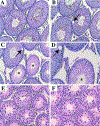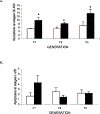Transgenerational effect of the endocrine disruptor vinclozolin on male spermatogenesis
- PMID: 16837734
- PMCID: PMC11451258
- DOI: 10.2164/jandrol.106.000349
Transgenerational effect of the endocrine disruptor vinclozolin on male spermatogenesis
Abstract
The current study was designed to examine the actions of a model endocrine disruptor on embryonic testis development and male fertility. Pregnant rats (F0) that received a transient embryonic exposure to an environmental endocrine disruptor, vinclozolin, had male offspring (F1) with reduced spermatogenic capacity. The reduced spermatogenetic capacity observed in the F1 male offspring was transmitted to the subsequent generations (F2-F4). The administration of vinclozolin, an androgen receptor antagonist, at 100 mg/kg/day from embryonic day 8-14 (E8-E14) of pregnancy to only the F0 dam resulted in a transgenerational phenotype in the subsequent male offspring in the F1-F4 generations. The litter size and male/female sex ratios were similar in controls and the vinclozolin generations. The average testes/body weight index of the postnatal day 60 (P60) males was not significantly different in the vinclozolin-treated generations compared to the controls. However, the testicular spermatid number, as well as the epididymal sperm number and motility, were significantly reduced in the vinclozolin generations compared to the control animals. Postnatal day 20 (P20) testis from the vinclozolin F2 generation had no morphological abnormalities, but did have an increase in spermatogenic cell apoptosis. Although the P60 testis morphology was predominantly normal, the germ cell apoptosis was significantly increased in the testes cross sections of animals from the vinclozolin generations. The increase in apoptosis was stage-specific in the testis, with tubules at stages IX-XIV having the highest increase in apoptotic germ cells. The tubules at stages I-V also had an increase in apoptotic germ cells compared to the control samples, but tubules at stages VI-VIII had no increase in apoptotic germ cells. An outcross of a vinclozolin generation male with a wild-type female demonstrated that the reduced spermatogenic cell phenotype was transmitted through the male germ line. An outcross with a vinclozolin generation female with a wild-type male had no phenotype. A similar phenotype was observed in outbred Sprague Dawley and inbred Fisher rat strains. Observations demonstrate that a transient exposure at the time of male sex determination to the antiandrogenic endocrine disruptor vinclozolin can induce an apparent epigenetic transgenerational phenotype with reduced spermatogenic capacity.
Figures








References
-
- Bayley M, Junge M, Baatrup E. Exposure of juvenile guppies to three antiandrogens causes demasculinization and a reduced sperm count in adult males. Aquat Toxicol (Amst). 2002;56:227–239. - PubMed
-
- Cooper RL, Goldman JM, Stoker TE. Neuroendocrine and reproductive effects of contemporary-use pesticides. Toxicol Ind Health. 1999;15:26–36. - PubMed
Publication types
MeSH terms
Substances
Grants and funding
LinkOut - more resources
Full Text Sources
Miscellaneous

